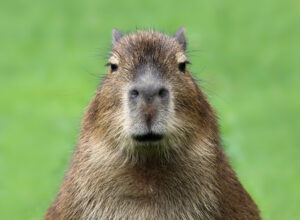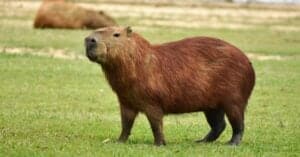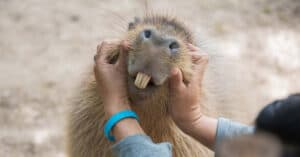Did you know that capybaras are the largest rodents in the world? These creatures can weigh up to 150 pounds and they are found in Central and South America. From their love of water to their impressive size, capybaras are undoubtedly some of the most interesting rodents in the world. They are also very social animals and enjoy spending time with other capybaras in their group. But what is a group of capybaras called, and how do they behave? Read on to find out!
What is a Group of Capybaras Called?
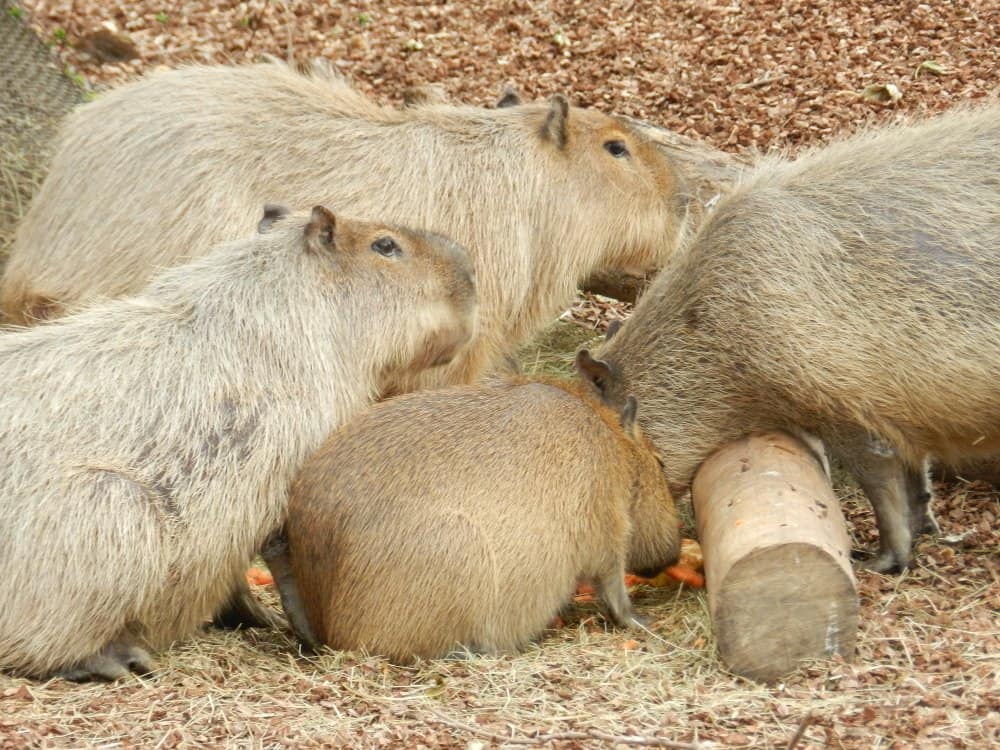
A group of capybaras is known as a herd. Capybaras usually live in groups of 10-20 individuals.
©Millie Bond – Copyright A-Z Animals
Capybaras are semiaquatic mammals that live together in groups and spend most of their time in water or mud. A group of capybaras is called a herd, and on average a capybara herd has 10-20 individuals. However, on occasion, there can be 40 capybaras or more in a single herd.
Capybaras are very social animals and enjoy playing together. They often groom each other and huddle together to stay warm. When one capybara notices something, the rest of the group will usually follow suit. For example, if one capybara sees a predator, it will make a loud noise to warn the others.
Within each capybara group or herd, there is a strict hierarchy that is kept in place through subtle cues and body language. This hierarchy helps the group function smoothly and efficiently, with everyone knowing their place within the group. Although capybaras are playful animals, they can also be aggressive toward outsiders who threaten their territory. So, if you’re ever thinking about joining a capybara herd, it’s best to ask permission first!
The Social Dynamics of a Group of Capybaras

Capybaras are very social animals, both within their own species and with other animals. Yellow-headed caracaras often help remove ticks from capybaras, in exchange for a free ride.
©iStock.com/slowmotiongli
The structure and social dynamics of a group of capybaras are fascinating. There is usually one dominant male that leads the group and defends his position by chasing away any potential challengers. The females and subordinate males will follow his lead. The dominant male will mate with the females in the group and father 75%-80% of their offspring. Dominant males do not receive better or more food or water with their position. However, they do often get preferential treatment when it comes to tick removal by yellow-headed caracaras.
When the dominant male of a group of capybaras dies or loses his position, everyone in the hierarchy moves up one step on the social ladder. If a subordinate male challenges the dominant male and loses, he remains with the herd and becomes a vigilant watch guard.
While the males tend to be more aggressive with each other, they will often play and groom each other when there are no females around. The females in the group usually form close bonds with each other and their offspring. The only time a hierarchical structure amongst capybara females occurs is in captivity if unfamiliar females from multiple groups are housed together.
Capybara Mothers and Alloparenting

Female capybaras nurse other infants within their herd. Caring for young capybaras is shared by all the females within the herd.
©Bradypus / CC BY-SA 3.0 – License
Within the capybara herd or group, the female capybaras share mothering responsibilities (also referred to as alloparenting). For example, not only will one female nurse her own infant, but she will nurse other infants within her herd as well. Female capybaras give birth within a two-week time frame at the end of the wet season, so their babies are all roughly the same age.
When baby capybaras are born, they almost immediately join their own nursery group with other young capybaras. This helps the babies to have their own community, and it helps the mothers to care for and nurse their young together with the other females of the herd.
Capybaras are excellent mothers, and some have even been known to “adopt” other species of animals as well! For example, a female capybara named Cheesecake at the Rocky Ridge Refuge in Arkansas is well-known for her motherly and loving nature. This sweet capybara takes on other foster species to care for and mother.
Cheesecake commonly fosters litter of puppies, sleeping and eating with them, and dealing out discipline when necessary, just like any good mother. She has also taken ducklings into her motherly care, as well as deer, tortoises, emus, miniature horses, and even older dogs. She and her fellow capybara, Cobbler, often care for one of the resident chickens, who seems to rather enjoy riding on the capybaras’ backs.
Capybara Communication
Capybaras are very interesting animals and there is still much scientists don’t know about them. However, recent studies have shed some light on their social lives. Capybaras communicate with each other using vocalizations and chemical signals, which helps them regulate their social encounters and stay aware of environmental cues.
Capybaras are very vocal animals and use a variety of sounds to communicate with each other. They use grunts, clicks, barks, and whistles, in addition to body language, to communicate. They also have impressive memories and can remember which individuals in their group are related to them. Studies show that vocal sounds differ between groups, suggesting that each group of capybaras has its own cultural language and understanding.
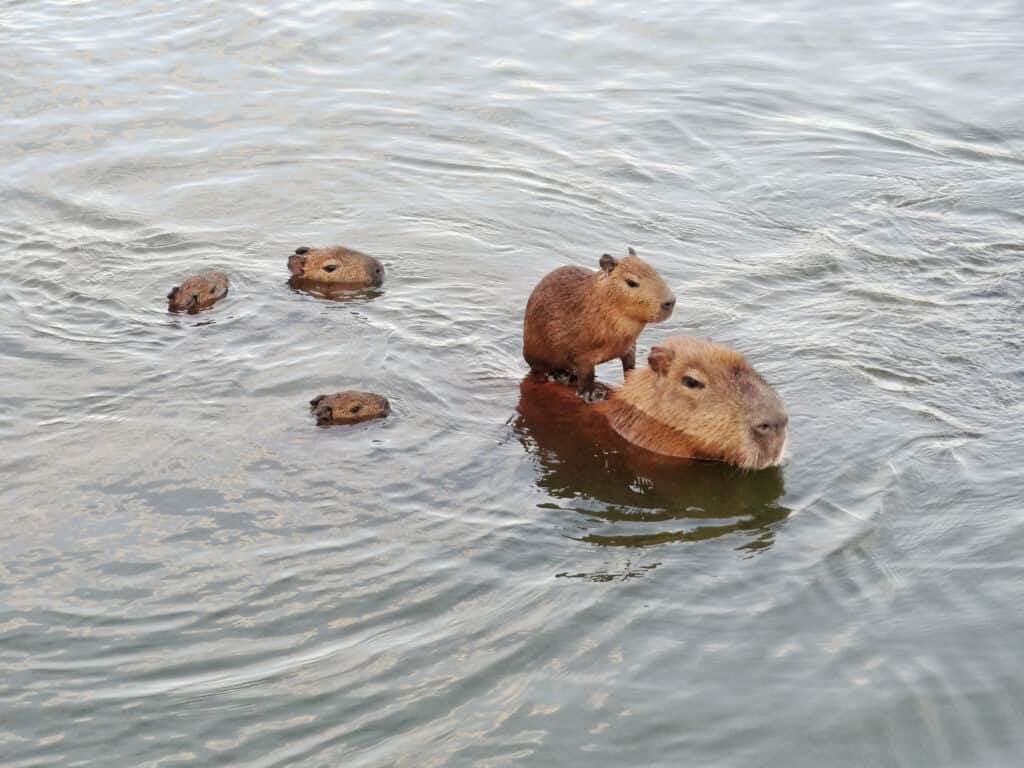
The capybara herd works together to protect their young, especially baby capybaras who are only two to four pounds when they are born.
©iStock.com/Yuina Takase
If a member of a group of capybaras senses a threat, it will make a loud, low-pitched bark to warn the rest of the group. The other capybaras will stand up and look alert. Often the threat goes away, so the capybaras return to resting or grazing. But if the threat continues, more capybaras will start barking, and eventually, they will try to run to the nearest watering hole.
Mothers may hide their babies in the water, or the adult capybaras will round up all the babies and circle them in the middle of the group. Adults then face outward, actively protecting the young capybaras of the herd.
Capybaras are fascinating creatures with unique behaviors and social lives. If you’re ever lucky enough to see a group of capybaras, you’re sure to be impressed by their size, social behavior, and intelligence.
Up Next:
- Capybara Location: Where Do Capybaras Live?
- Capybara Predators: What Eats Capybaras?
- Are Capybaras the Biggest Rodents in the World?
- Capybara Size: How Much Do Capybaras Weigh?
The photo featured at the top of this post is © Giedriius/Shutterstock.com
Sources
- Research Gate, Available here: https://www.researchgate.net/publication/278709594_Capybara_Social_Behavior_and_Use_of_Space_Patterns_and_Processes
- Wiley Online Library, Available here: https://onlinelibrary.wiley.com/doi/abs/10.1111/j.1439-0310.2010.01853.x
FAQs (Frequently Asked Questions)
How many capybaras are in a group or herd?
On average, there are 10-20 members in a herd of capybaras. Some groups may have many 40 or more, however, and capybaras in the Amazon have been reported living in smaller single-family groups.
Are capybaras friendly?
Yes, capybaras are known for being some of the friendliest animals on earth! They commonly “adopt” orphan capybara babies, as well as babies from other animals species. Capybaras are calm and chill animals, and tend to get along with other animals and even humans.
Are capybaras dangerous?
In general, capybaras are calm and friendly animals. In rare instances, some people have even kept capybaras as pets. However, capybaras are extremely protective of their herds and can act aggressively toward trespassers. They also have sharp teeth that can cause damage.
Are capybaras smart?
Capybaras are friendly and social, and live in herds with several other individuals. Their groups are structured with sophisticated and complex hierarchies and require high levels of emotional intelligence. These cute and cuddly rodents are at least as smart as most dogs.
Where do capybaras live?
Capybaras live in Central and South America. They can be found in nearly every country in Central and South America, with the exception of Chile. In addition, there have been reports of capybaras in Florida, although there is yet to be an officially confirmed population in the state.
Thank you for reading! Have some feedback for us? Contact the AZ Animals editorial team.




